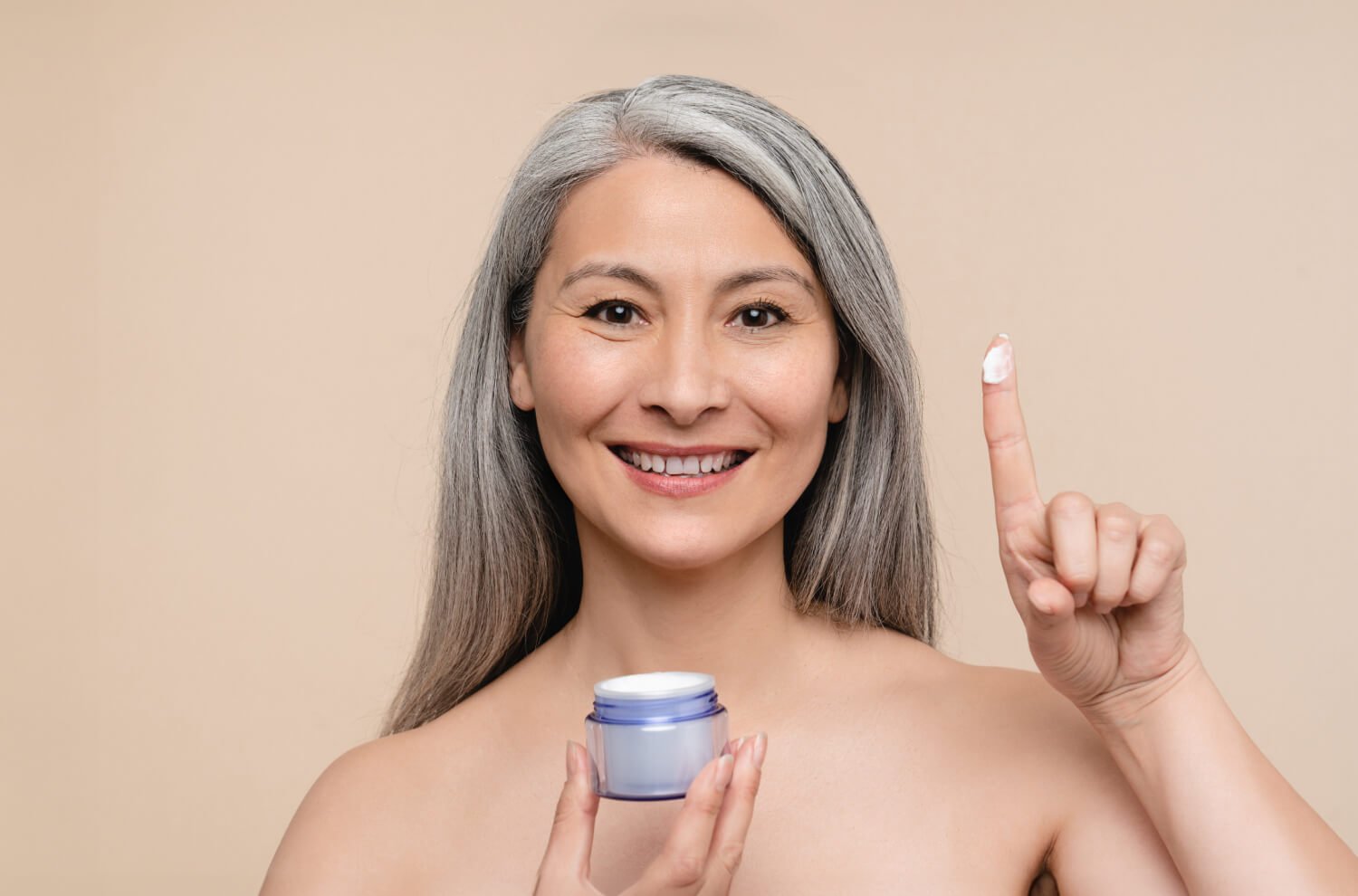
The world of skincare may be very focused on “anti-aging” products, but it’s important to recognize that skin aging is a normal process. We’re all going to experience this, one way or another! For that reason, it’s important that we all understand how skin aging actually works; that should give us a better understanding of any changes we experience and, at the same time, help us adjust our expectations regarding what our cosmetics can and cannot do. Can a boost collagen serum? Sure! But can it create new bone material to improve facial definition? Probably not. Skin aging can affect the skin in a variety of ways, and skincare can only prevent or correct it in so many ways. There are many layers to this–pun intended!
On this post:
- What are the signs of aging on the skin?
- The mechanism of skin aging
- How fat, bone, and muscle changes also affect your skin
- Common signs of visible skin aging
What are the signs of aging on the skin?
Aging is different for everyone. Some people will start noticing wrinkles earlier than others (if you have dry skin, this is probably you), while others will notice skin sagging as their first sign of aging. Regardless of this initial progression, however, over time and without specific treatment, most people will experience skin aging in more or less the same way:
- Wrinkles;
- Discolored skin;
- Rough skin;
- Sun spots/age spots;
- Dark under-eye circles;
- Sagging skin;
- Dry skin;
- Loss of elasticity;
- Visible pores.
Most people end up experiencing these signs of aging because the mechanisms of aging are transversal and tend to affect all skin types, sooner or later. But how do these signs of aging come to be, and why do they look the way they do?
The mechanism of skin aging
Skin aging is due to two main factors: intrinsic aging and extrinsic aging. And what are these, you ask? Well, intrinsic aging is the programmed aging your body is meant to endure by just aging. Extrinsic aging, however, relates to the environment you live in.
Intrinsic aging, aka Chronological aging
Cells are programmed from birth to endure a certain degree of division. With each division, a small part of the chromosomes, called telomeres, shorten a bit. This reduces the ability for skin regeneration. Additionally, in women, hormonal changes related to menopause also have a significant impact the skin, leading to less firmness, dryness, and rough texture. Lastly, from around age 25, elastin and collagen production reduce by approximately 1% every year. These proteins are what give the skin support and elasticity, and losing them leads to sagging skin.
Extrinsic aging, aka The exposome
While chronological aging contributes to the overall signs of aging, what really matters (and which you can actually have some control over) is extrinsic aging. In 2017, the L’Oréal Research and Innovation Group coined the term “exposome” and over the years it has been adopted by virtually everyone in the industry. And what is this exposome, exactly? It’s everything around you that impacts how your skin ages, and it’s thought to contribute to 70-80% of overall skin aging signs:
- External: urban environment, air pollution, sound pollution, climate, exposure to UV radiation, the amount of green spaces around you, and how much light you can take in during the day (commonly related to shift work);
- Internal: smoking, exercise habits, nutrition, sleep patterns, mindfulness habits, and stress levels.
Leading a balanced healthy life in an area with low pollution, lots of green spaces and low sun exposure is a great way to address skin aging. However, this is an idyllic scenario that’s unfortunately unachievable to most people. By improving some of these areas, however, you may be able to reduce aging signs.
The most relevant area to address is, without any doubt, sun exposure. Avoiding exposure when the UV index is above 7 is a great way to prevent signs of aging, and also drastically reduces the risk of skin cancer. Also, make sure you’re wearing your favorite sunscreen daily because there is always some degree of exposure, even if you’re not going out when it’s hot and sunny.
How fat, bone, and muscle changes also affect your skin
While the skin itself suffers a lot of changes with aging, the layers beneath it are also affected by their own mechanisms of aging. This means, in short, that changes in fat, bone, or muscle have their own effects on the appearance of the skin, and that these effects cannot be resolved with cosmetics, as they originate in much deeper layers.
Fat pad changes
Your body contains fat pads that, when you’re young, are located near the cheekbones or the forehead. With age, these fat pads shift and relocate, and one of the places where this is most visible is under the eyes. As the fat pads that used to be under your eyes shrink and reveal the blood vessels underneath, you get dark circles for the first time in your life. This relocation also creates a shadowy area, thus creating an illusion of hollowness and darkness around the area.
Bone reabsorption
With age, there is also a greater rate of bone reabsorption. On the face, one of the main areas affected is the area around the eyes and cheekbones. This leads to a loss of facial structure and volume, which contributes to that look of “sagging” skin. It also contributes to more shadows on the face, thus increasing the perception of dark circles.
Loss of muscle tone
Due to the fact that facial muscles partly lose their strength, the skin also looks like it’s sagging over time. This can not only create the appearance of the famous “double chin”, but also increases nasolabial folds.
Common signs of visible skin aging
Now that we’ve talked about everything that can affect the appearance of the skin, from the surface to the deepest layers of our body, let’s learn more about the specific causes of some common signs of aging:
Wrinkles
Wrinkles happen because, physiologically, there is a reduction in the number of cells that synthesize collagen and vessels that supply the skin. Additionally, due to environmental aggressions, the skin proteins get destroyed. This can be due to glycation and free radicals, among other causes.
Skin sagging and changes in elasticity
Sun exposure gradually leads to sagging of skin; this happens through the loss of fibril and collagen, which makes the skin sag and lose elasticity. On the other hand, the overproduction of deformed elastin may happen. This elastin makes the skin overextend, which leads to elastosis.
Dark spots
Sun exposure leads to melasma and age spots. The overstimulation of melanocytes leads to the overproduction of melanin, a skin pigment. This overstimulation tends to happen in localized areas, thus leading to dark spots.
Dark circles
The shrinking and relocation of fat pads, as well as bone reabsorption, leads to a hollowing of the eye contour area. Thus, with more shadow and with the skin closer to the blood vessels, it looks like there are larger and more pronounced dark circles.
Dry skin
Dry skin is related to hormonal changes. Low levels of estrogen tend to induce overall dryness, which also manifests in the skin. Lower levels of hyaluronic acid and naturally occurring skin oils also result in drier skin.
As you can see, there are many factors that influence skin aging. Some of them can be addressed by a healthier lifestyle, others you can only address in a clinic, and others may actually benefit from the use of cosmetics! To help minimize signs of aging, look for products with retinol. Scared to use retinol? We actually have a guide to get you started on retinol and another one with the best retinol products for you. Don’t forget to combine them with a great sunscreen: this will not only help you complement the benefits of your retinol regimen, but also help you achieve healthier skin!
Pharmacy Technician & Beauty Writer


